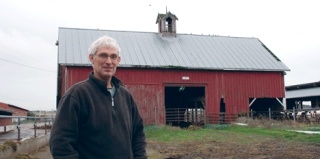Until May 2007, Wilbur Bishop ran a dairy farm. The milk cows are gone now, but he still raises heifers — cows that have yet to calf.
The former milk house contains a large green John Deere tractor and some day will become a showcase room and interpretive center for the farm’s history. Through a pair of heavy doors is the former milking parlor turned workshop.
Built in 1969, these buildings are relatively new to Ebey’s Reserve. And it’s made economic sense to change the buildings to serve the changing character of the Bishop farm.
The preservation of historic barns in Ebey’s Reserve heavily relies on adaptive uses, said Mark Preiss, reserve manager, adding that barn owners cannot continue to maintain the structures if they are unable to make economic sense of their use.
Bishop also owns the LeSourd Barn and Granary. Because of their age, these buildings require more time and money to sustain.
While standing in the aging, wooden barn, which was built around 1899, several mud-caked heifers curiously stare when bipeds enter their barn. Over a span of 30 years, Bishop raised the foundation, replaced structural beams and attached cables to opposing walls to maintain the barn’s shape.
“This barn here has been so intensely used,” he said. “I’m going to continue to use it.”
While the barn has always been used for cows, it has gone through changes over the years to adapt to the type of livestock, Bishop said.
The granary, built in 1923, receives even less use, and one wall is visually bowing outward. Take a closer look at the walls and the evidence of history is blatantly obvious. Dates, names and simple addition equations cover the wall, apparently for grain orders. Many of the names match those found on the headstones in Sunnyside Cemetery, just up the hill.
Bishop applied for a grant to aid in the repairs of the barn and granary, but did not receive a grant award this year. As time and money will allow, he’ll try his best to keep the barn and granary standing.
“I appreciate the barns, I appreciate the land and I feel fortunate to live here,” he said.
Up the road, the Smith barn, homestead and granary stand tall among the surrounding fields. Although the three structures closely resemble historic photos, the barn and granary have gone through some big changes.
Georgie Smith and her husband transformed the dilapidated granary into their home.
Georgie grew up on the Smith farm but didn’t do much in the way of farming. She left the farm to pursue a journalism degree at Washington State University and worked at a paper for several years before returning in 1996.
“This is where my family was,” she said, adding that her five-year effort to change the granary into her home garnered a bit of attention from the neighbors.
“I feel strongly that we need to start focusing on the out buildings,” she said. “Many of the original homes are in OK shape, but the barns and out buildings are in dire straits. I like to think about it from a planning perspective, to sensitively rehabilitate them into housing or otherwise.”
And that is just what she did with the granary, said Preiss.
“It’s a really wonderful example of how to use and reuse that historic building,” he said.
The barn is also still in use on the Smith farm, currently for Georgie’s organic farming business, storage and occasional barn dances. It was originally used to house the farm’s workhorses, milk cows and to store hay, said Bill Smith, Georgie’s father.
As a kid, Bill remembers the barn full of beef cattle, squash and grain. The cattle went to auction and the grain was shipped out of Mount Vernon by railroad, he said.
“There’s always upkeep on it,” he said.
The Smiths also applied for grant money, but were unsuccessful with their application this year.
Unlike the Bishop and Smith families, Bob and Cheryl Engle, owners of the Sherman hog barn, were lucky to receive grant money through the Washington Heritage Barn Program to restore their barn, which was built in 1942 from wood that came out of the World War II Fort Casey barracks.
Cheryl attributes their successful grant application to Harrison Goodall, an architectural conservator.
“He devoted a lot of time to evaluate the condition of the barn and write up the grant,” she said.
The grant is being used to repair rot on one side of the barn and replace its 196 windows.
Taking after its name, the 200-by-60-foot Sherman barn was built for hogs. The animals dined on mess-hall scraps from Fort Casey and the Navy base, Cheryl said.
As a child, she remembers her father kept turkeys in the barn, adding that it’s also been used for sheep and the storage of squash, but now it stores barley.
Cheryl was born on the farm and she and her husband, Bob, bought it from her parents in the 1970s. Up the hill there was another barn, but it was destroyed by arson in May 2007. The arsonists were never caught, she said.
Although the rot-damage was more extensive than they originally thought, the Engles are pitching in to make the restoration happen. Cheryl spends time painting primer on the barn’s new siding and spends 10 hours on each window, adding that she still has many, many more to go.
These barns will be part of the “Hipped, Gabled, Board and Battened” tour during the Ebey’s Forever Conference, which will take place Friday and Saturday Nov. 7 and 8. For more information about the conference, contact Lynda Richards at Lynda_A_Richards@partner.nps.gov, or 678-6084.



